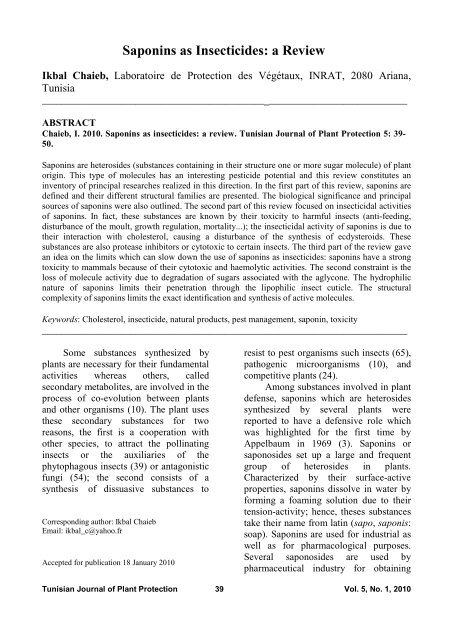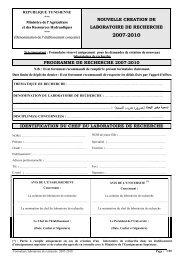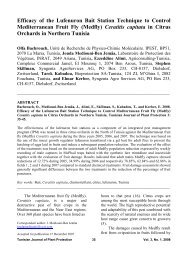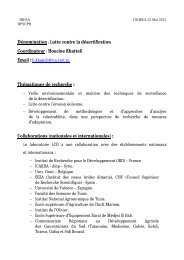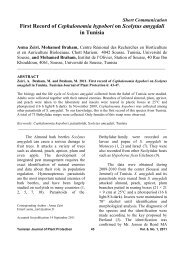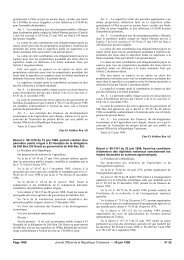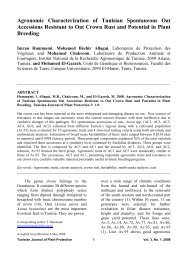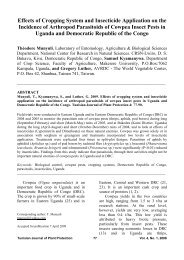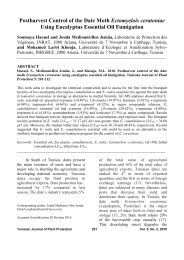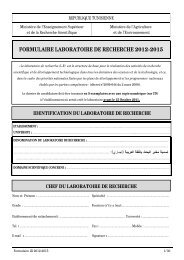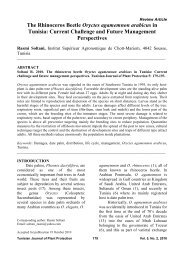Saponins as Insecticides: a Review - Iresa
Saponins as Insecticides: a Review - Iresa
Saponins as Insecticides: a Review - Iresa
You also want an ePaper? Increase the reach of your titles
YUMPU automatically turns print PDFs into web optimized ePapers that Google loves.
<strong>Saponins</strong> <strong>as</strong> <strong>Insecticides</strong>: a <strong>Review</strong><br />
Ikbal Chaieb, Laboratoire de Protection des Végétaux, INRAT, 2080 Ariana,<br />
Tunisia<br />
__________________________________________________________________________<br />
ABSTRACT<br />
Chaieb, I. 2010. <strong>Saponins</strong> <strong>as</strong> insecticides: a review. Tunisian Journal of Plant Protection 5: 39-<br />
50.<br />
<strong>Saponins</strong> are heterosides (substances containing in their structure one or more sugar molecule) of plant<br />
origin. This type of molecules h<strong>as</strong> an interesting pesticide potential and this review constitutes an<br />
inventory of principal researches realized in this direction. In the first part of this review, saponins are<br />
defined and their different structural families are presented. The biological significance and principal<br />
sources of saponins were also outlined. The second part of this review focused on insecticidal activities<br />
of saponins. In fact, these substances are known by their toxicity to harmful insects (anti-feeding,<br />
disturbance of the moult, growth regulation, mortality...); the insecticidal activity of saponins is due to<br />
their interaction with cholesterol, causing a disturbance of the synthesis of ecdysteroids. These<br />
substances are also prote<strong>as</strong>e inhibitors or cytotoxic to certain insects. The third part of the review gave<br />
an idea on the limits which can slow down the use of saponins <strong>as</strong> insecticides: saponins have a strong<br />
toxicity to mammals because of their cytotoxic and haemolytic activities. The second constraint is the<br />
loss of molecule activity due to degradation of sugars <strong>as</strong>sociated with the aglycone. The hydrophilic<br />
nature of saponins limits their penetration through the lipophilic insect cuticle. The structural<br />
complexity of saponins limits the exact identification and synthesis of active molecules.<br />
Keywords: Cholesterol, insecticide, natural products, pest management, saponin, toxicity<br />
__________________________________________________________________________<br />
Some substances synthesized by<br />
plants are necessary for their fundamental<br />
activities where<strong>as</strong> others, called<br />
secondary metabolites, are involved in the<br />
process of co-evolution between plants<br />
and other organisms (10). The plant uses<br />
these secondary substances for two<br />
re<strong>as</strong>ons, the first is a cooperation with<br />
other species, to attract the pollinating<br />
insects or the auxiliaries of the<br />
phytophagous insects (39) or antagonistic<br />
fungi (54); the second consists of a<br />
synthesis of dissu<strong>as</strong>ive substances to<br />
Corresponding author: Ikbal Chaieb<br />
Email: ikbal_c@yahoo.fr<br />
Accepted for publication 18 January 2010<br />
resist to pest organisms such insects (65),<br />
pathogenic microorganisms (10), and<br />
competitive plants (24).<br />
Among substances involved in plant<br />
defense, saponins which are heterosides<br />
synthesized by several plants were<br />
reported to have a defensive role which<br />
w<strong>as</strong> highlighted for the first time by<br />
Appelbaum in 1969 (3). <strong>Saponins</strong> or<br />
saponosides set up a large and frequent<br />
group of heterosides in plants.<br />
Characterized by their surface-active<br />
properties, saponins dissolve in water by<br />
forming a foaming solution due to their<br />
tension-activity; hence, theses substances<br />
take their name from latin (sapo, saponis:<br />
soap). <strong>Saponins</strong> are used for industrial <strong>as</strong><br />
well <strong>as</strong> for pharmacological purposes.<br />
Several saponosides are used by<br />
pharmaceutical industry for obtaining<br />
Tunisian Journal of Plant Protection 39 Vol. 5, No. 1, 2010
drugs or by cosmetics industry for their<br />
detergent property (12).<br />
In this review, our interest will be<br />
focused on use of these substances <strong>as</strong><br />
insecticide molecules.<br />
HO<br />
CH 2OH<br />
O<br />
OH<br />
OH<br />
1'''<br />
CH2OH OO<br />
3<br />
OH<br />
1'<br />
O OO<br />
CH3 1'' O<br />
OH OH<br />
HO<br />
CH 3<br />
O<br />
OH OH<br />
1''''<br />
19<br />
1<br />
Saponin presentation.<br />
Chemical structure of saponins.<br />
<strong>Saponins</strong> or saponosides are heterosides<br />
composed of two parts: a water-soluble<br />
glucidic chain and a generally triterpenic<br />
or steroïdic liposoluble structure<br />
(aglycone) (Fig. 1).<br />
Fig. 1. Example of steroidic saponin with 4 sugar chains: Parquisoside 1 extracted from Cestrum parqui (7)<br />
The sugars constitutive of the skeleton is usually indicated by the<br />
saponosides can be: D-glucose D- spirostane term. In fresh plants, it is not<br />
galactose, L-arabinose, L-rhamnose, Dxylose,<br />
D-fructose or D-glucuronic acid.<br />
rare that hydroxyl in C26 is engaged in a<br />
connection with a sugar. The structure<br />
Generally, the sugar part of heteroside can be pentacyclic; it is called in this c<strong>as</strong>e<br />
consists of one or two linear or ramified furostane. Some authors include<br />
oligosides. The molecule can include 11 glycoalcaloides with saponins having<br />
sugars (but generally 3 to 5) (12).<br />
steroïdic aglycone group (11). The<br />
<strong>Saponins</strong> are cl<strong>as</strong>sified by the glycoalcaloides have the same structure<br />
majority of the authors in two groups <strong>as</strong> a spirostanic steroidic aglycone, except<br />
according to the nature of their aglycone the existence of an atom of nitrogen often<br />
(Fig. 2): (i) saponosides with steroïdic on the level of the sixth cycle (12).<br />
aglycone, (ii) saponosides with triterpenic<br />
The triterpenic aglycones, come<br />
aglycone. The steroidic aglycones from the cyclization of the (3S)-2,3-<br />
represented in Fig. 2 have a whole epoxy-2,3-dihydrosqualene. This<br />
skeleton with 27 carbon atoms. These cyclization gives pentacyclic compounds<br />
molecules come from an intramolecular like dammaranes, oleananes, ursanes, and<br />
cetalisation which intervenes after hopanes. The majority of triterpenic<br />
oxidation in C16, C22 and C26 of a<br />
cholestanic precursor taking into account<br />
sapogenins belong to these four b<strong>as</strong>ic<br />
skeletons (Fig. 2) (12).<br />
spiro-nature of C22; this hexacyclic<br />
Tunisian Journal of Plant Protection 40 Vol. 5, No. 1, 2010<br />
5<br />
6<br />
Sugar chain<br />
18<br />
O<br />
22<br />
O<br />
OH<br />
24<br />
16<br />
15<br />
Aglycone
Sugars<br />
Sugars<br />
Triterpenic aglycone<br />
Steroidic aglycone<br />
Origin of saponins. Several<br />
saponosides substances are extracted from<br />
Glycyrrhiza glabra, Agave attenuata,<br />
Panax ginseng, Saponaria officinalis<br />
(20), Allium sativum (22), Medicago<br />
sativa (43), and Cestrum parqui (18). In<br />
addition to their plant origin, saponins can<br />
be obtained from some marine animals.<br />
Some saponins are isolated from<br />
Antarctic starfish belonging to Asteriidae<br />
family; triterpenic saponins are also<br />
isolated from marine sponges<br />
(Ectyopl<strong>as</strong>ia ferox) (13).<br />
<strong>Saponins</strong> are also found in defensive<br />
secretions of certain insects. Triterpenic<br />
saponins are isolated from Chrysomelidae<br />
especially the Platyphora genus (41).<br />
Species of this genus sequester saponins<br />
from their plant hosts to use them for<br />
their own defense (53).<br />
R<br />
O<br />
Fig. 2. Different possible structures of saponin aglycones (11, 12)<br />
Oleanane<br />
Hopane<br />
Dammarane<br />
Ursane<br />
Biological significance of saponins.<br />
The various structures of saponins are<br />
involved in several biological activities<br />
with some beneficial or toxic effects.<br />
These molecules have a nonspecific but<br />
enough significant activities to control the<br />
interaction existing between plants and<br />
<strong>as</strong>sociated organisms (28, 37).<br />
Several authors have already shown<br />
the defensive role of saponins. In fact,<br />
these substances protect plants from<br />
phytopathogenic microorganisms,<br />
phytophagous mammalian and insects<br />
(28, 34, 37, 42).<br />
Moreover, saponins are known for<br />
their detergent properties, i.e. they have<br />
the possibility of forming micelles with<br />
lipids. They can also interact with<br />
cholesterol to form insoluble complexes.<br />
Tunisian Journal of Plant Protection 41 Vol. 5, No. 1, 2010<br />
R<br />
R=<br />
R=<br />
R=<br />
R=<br />
R=<br />
R=<br />
R=<br />
O<br />
N<br />
Spirostane<br />
Glycoalcaloid<br />
Furostane
The majority of the biological properties<br />
of saponins rise from these fundamental<br />
characteristics (26, 35).<br />
Insecticidal activity of saponins.<br />
Researches concerning the<br />
interaction between plants and<br />
phytophagous insects are multiple<br />
particularly those focused on toxicity of<br />
certain substances toward insects. This<br />
toxicity appears primarily in the three<br />
following ways.<br />
Interference with the feeding<br />
behavior. Some saponins have<br />
antifeeding activity <strong>as</strong> is the c<strong>as</strong>e of<br />
saponins extracted from Ilex apocea<br />
which inhibit the food uptake of<br />
Limantria dispar (8). These saponins are<br />
antifeeding for a mite species<br />
(Oligonichus illicis) and for two<br />
caterpillar’s species (Hyphantria cunea<br />
and Malacosoma americanum) (33, 37).<br />
Discoraceae plants shows antifeeding<br />
activity to Acromynes octospinosus ant<br />
(14, 25).<br />
Rich saponin alfalfa varieties<br />
applied on flour worm larvae Tenebrio<br />
molitor cause a decre<strong>as</strong>e of dry food<br />
quantity metabolized by this insect (42).<br />
The incorporation of saponins of alfalfa<br />
in the artificial diet of Ostrinia nubilalis<br />
incre<strong>as</strong>es the larvae weight loss (36).<br />
Similar results were reported on<br />
Spodotera littoralis larvae treated by<br />
fifteen various purified saponins obtained<br />
from several plants (1). Agrell et al. (2)<br />
also noticed that S. littoralis larvae<br />
consumed less significant quantities of<br />
damaged alfalfa leaves than those of<br />
control leaves; this phenomenon w<strong>as</strong><br />
explained by the incre<strong>as</strong>ed synthesis of<br />
two triterpenic saponins by the plants<br />
under biotic stress.<br />
In the same way, the addition of<br />
saponins of certain leguminous plants<br />
(chickpe<strong>as</strong>, garden pe<strong>as</strong>, broad beans,<br />
haricot beans, lentils, peanuts) in the<br />
artificial diet of Callosbruchus chinensis<br />
inhibits its food uptake; this inhibition is<br />
stronger when saponins used originated<br />
from different host plants (3).<br />
Pluetella xylostella is a<br />
phytophagous specific insect consuming<br />
plants belonging to Br<strong>as</strong>sicaceae family.<br />
It w<strong>as</strong> noticed that the larvae are unable<br />
to attack one Br<strong>as</strong>sicaceae species<br />
(Barbarea vulgaris) (45). The separation<br />
of the fractions of this plant revealed the<br />
involvement of triterpenic saponin, with<br />
two sugars in C3 position, in the important<br />
inhibition of the food uptake activity (46).<br />
A spirostanic saponin isolated from<br />
Solanaceae (Solanum laxum) showed an<br />
antifeeding activity against Schizaphis<br />
graminum aphid on artificial diet (48).<br />
<strong>Saponins</strong> extracted from Blanites<br />
roxburghii, Agave cantala and Ph<strong>as</strong>eolus<br />
vulgaris were tested for their antifeeding<br />
activity on Spilosoma obliqued larvae.<br />
Monodesmoside saponins are shown to<br />
be more active than the bidesmoside<br />
ones. <strong>Saponins</strong> having the le<strong>as</strong>t<br />
significant number of sugar chains were<br />
most active (31).<br />
Glycoalcaloids extracted from the<br />
genus Solanum species inhibit the weight<br />
incre<strong>as</strong>e of Tribolium c<strong>as</strong>taneum and<br />
Manduca sexta. In these compounds,<br />
neither the aglycone alone nor when<br />
<strong>as</strong>sociated with sugars present this<br />
inhibitory activity (55).<br />
Works on Cestrum parqui saponins<br />
show a repulsive activity against the<br />
caterpillar of Pieris br<strong>as</strong>sicae, <strong>as</strong> well <strong>as</strong><br />
a moderate antifeeding activity for<br />
Spodoptera littoralis and Helicoverpa<br />
armigera larvae (15).<br />
Growth Regulation. Several<br />
researches show that saponins are able to<br />
regulate the growth of many insect<br />
species. These studies resumed in Table 1<br />
concern purified or crude saponins<br />
Tunisian Journal of Plant Protection 42 Vol. 5, No. 1, 2010
extracted from several plants. The effect<br />
of saponins is generally characterized by<br />
developmental stages duration<br />
disturbance and moulting failure. The<br />
mode of action of “Insect Growth<br />
Regulator’s” activity is discussed below.<br />
Table 1. Growth regulation effects of saponins on some insects<br />
Insect species <strong>Saponins</strong> Effects Reference<br />
Ostrinia nubilalis alfalfa saponins Lengthening of the larval stages (36)<br />
Spodoptera littoralis alfalfa saponins Lengthening of stages, delay of time necessary<br />
to reach the maximum size in l<strong>as</strong>t larval stage,<br />
delay of the interval separating the l<strong>as</strong>t larval<br />
stage and the nymphal moulting, and delay of<br />
time necessary for the emergence of the adults<br />
(1)<br />
Culex fatigans commercial saponins Larvae show more pronounced pigmentation<br />
and deterioration of the head and abdomen<br />
shape<br />
(50)<br />
Acrolepiosis <strong>as</strong>sectella Allium porrum saponins Larvae present ecdysial disturbances, which<br />
often finish by characteristic malformations:<br />
larvae with double head<br />
(5, 28, 29)<br />
Acrolepiosis <strong>as</strong>sectella commercial digitonin Ecdysial failure (6)<br />
Collosobruchus chinensis Fabaceae saponins Reduction in the rate of adult emergence (55)<br />
Spodoptera littoralis Cestrum parqui saponins Impossibility to get free from the old cuticle<br />
during the molting process<br />
(16)<br />
Shistocerca gregaria Cestrum parqui saponins Ecdysial disturbances (9)<br />
Entomotoxicity. The crude saponins<br />
extracted from Cestrum parqui injected to<br />
the L5 Schistocerca gregaria larva<br />
incre<strong>as</strong>e insect mortality (9). In the same<br />
way, the spray of tomato leaves by 0.1 to<br />
0.2% of an aqueous solution of alfalfa<br />
saponins reduces the number of<br />
Tetranychus urticae mite and Pharodon<br />
sp. aphids by 85 and 90%, respectively.<br />
<strong>Saponins</strong> of alfalfa can also cause<br />
mortalities on eggs of T. urticae (37).<br />
The introduction of alfalfa saponins<br />
into the food of Ostrinia nubilalis cause<br />
larval mortalities reaching 100% for the<br />
L2 larval stages. Mortalities were also<br />
recorded for the nymphal stage;<br />
moreover, only 60% of the treated<br />
chrysalis emerge (36). Treated by 100<br />
ppm saponin of alfalfa leaves, Spodoptera<br />
littoralis shows a cumulative mortality of<br />
90% at the larval and the nymphal stages<br />
(1). Various forms of chronic toxicity <strong>as</strong> a<br />
reduction in the fertility of the females<br />
and the blossoming eggs rate are observed<br />
in the same insect species (1). The<br />
saponins extracted from the leaves and<br />
the roots of the alfalfa are toxic for<br />
Leptinotarsa decemlineata larvae (49).<br />
The addition of aginoside 1<br />
(steroidic saponin) to the artificial diet of<br />
Acrolepiosis <strong>as</strong>sectella larvae with an<br />
amount of 0.9 mg/g, causes 56% of<br />
mortality (29). The commercial saponins<br />
extracted from Quillaja saponaria have a<br />
larvicidal activity against the mosquitos<br />
larvae of two species Aedes aegypti and<br />
Culex pipiens; 100% of mortality is<br />
obtained by using amounts of 1000 mg/l<br />
during 5 days (40).<br />
Crude saponins of Cestrum parqui<br />
showed a variable toxicity on various<br />
tested insects (Schistocera gregaria, S.<br />
littoralis and Tribolium confusum) but the<br />
most significant toxicity w<strong>as</strong> observed on<br />
the larvae of the mosquito Culex pipiens<br />
(14).<br />
Tunisian Journal of Plant Protection 43 Vol. 5, No. 1, 2010
Forming insoluble complexes with<br />
saponins, cholesterol is not absorbed any<br />
more by the digestive system of various<br />
animal species. The mechanism of<br />
formation of the cholesterol/saponin<br />
complexes is still unknown. Certain<br />
authors suggest a chemical reaction<br />
between the saponic aglycone and the<br />
lipophylic sites of cholesterol (51); Mitra<br />
and Dungan (35) show that there is a<br />
formation of micelle or spheres structures<br />
between cholesterol and saponin<br />
molecules.<br />
The hypocholesterolemic activity of<br />
saponins w<strong>as</strong> largely studied in many<br />
mammals (20, 34). Is such<br />
cholesterol/saponin interaction possible in<br />
insects? Theoretically yes, since insects,<br />
while being unable to synthesize<br />
cholesterol, they use this substance in the<br />
biosynthesis of the ecdysone (moulting<br />
hormone) and various other ecdysteroids.<br />
This hypo- hypocholesterolemic<br />
mechanism, similar to that observed in<br />
the mammals following the action of<br />
saponins, could interfere with the<br />
biosynthesis of the ecdysone and explain<br />
the disturbance of moulting process often<br />
observed following ingestion of Cestrum<br />
parqui leaves (9) or by the incorporation<br />
of extracts in the insect diet (15).<br />
Various natural or synthesized<br />
insecticidal substances affecting the<br />
biosynthesis or the mechanisms of action<br />
of ecdysone, have a disturbing effects on<br />
insect growth and moulting (5, 6). In fact,<br />
saponins are substances often cited in the<br />
literature <strong>as</strong> provoking difficulties of<br />
exuviations and malformations of various<br />
insect species. Some of these works<br />
evoke the possibility of interaction of<br />
saponins with cholesterol but no<br />
demonstration w<strong>as</strong> made until now.<br />
Some experiments (Table 2) showed<br />
an Insect Growth Regulator activity of<br />
Cestrum parqui saponins. Indeed, insects<br />
consuming saponins supplemented with<br />
cholesterol support better the toxic effect<br />
of saponins; this fact is in favor of an<br />
antagonistic effect of cholesterol and<br />
consolidates our <strong>as</strong>sumption concerning<br />
the mode of action of saponins (17).<br />
Table 2. Effects of cholesterol addition in the diet of some insects treated with different saponins<br />
Insect species <strong>Saponins</strong> used Effects of cholesterol addition Reference<br />
Acrolepiopsis <strong>as</strong>sectella Aginosid Reduce the larval mortality from 56%<br />
to 22% and moulting failures from 19<br />
to 8%<br />
(29)<br />
Acrolepiopsis <strong>as</strong>sectella Digitonin Reduction in the death rate from 62 to<br />
27%<br />
(5)<br />
Acrolepiopsis <strong>as</strong>sectella Digitonin Removes completely the toxicity (6)<br />
Tribolium confusum Cestrum parqui saponins Reduction of larval mortality from 95<br />
to 45%<br />
(17)<br />
Tenebrio molitor Alfalfa saponins Elimination of the saponin toxicity (43)<br />
Tribolium c<strong>as</strong>taneum Solmargine, Sol<strong>as</strong>onine, Tomatine Incre<strong>as</strong>e the viability of treated larvae (55)<br />
Several authors (29, 43, 55) suppose<br />
a possible interaction saponin/cholesterol<br />
causing cholesterimic deficit in insect,<br />
disturbing the ecdysone synthesis. This<br />
complexation can occur in food,<br />
hemolymph, or inside the insect cells.<br />
Studies trying to react in vitro cholesterol<br />
with saponin remained unfruitful<br />
although the use of various methods and<br />
solvents (14), where<strong>as</strong> certain works<br />
reported formation of a precipitate with<br />
similar reactions (26, 51).<br />
The mechanisms of interaction of<br />
saponins with cholesterol are still<br />
unknown and according to certain<br />
authors, there is no formation of an<br />
intermediate compound but a spherical<br />
structure, intercalation between saponin<br />
Tunisian Journal of Plant Protection 44 Vol. 5, No. 1, 2010
molecule and cholesterol, called micelle<br />
(35) or tubular structures (32) may be<br />
involved. Consequently, saponins do not<br />
block cholesterol or other phytosterols in<br />
the food, but this reaction could take<br />
place later inside insect body where other<br />
conditions are satisfied (pH, enzymatic<br />
arsenal).<br />
Other scientific attempts to<br />
proportionate cholesterol in insects<br />
consuming saponins did not lead to<br />
reliable results because undoubtedly of<br />
methodologies used which would be<br />
unsuited to very low circulating<br />
cholesterol rates. Cholesterol is not in<br />
majority in the phytophagous insect food<br />
because plants contain other types of<br />
sterols <strong>as</strong> sitosterol and sigm<strong>as</strong>terol. It is<br />
possible that this interference between<br />
saponin and cholesterol would take place<br />
inside insect cells (17). Some authors<br />
suppose the possibility of interaction of<br />
saponin with ecdysteroid receptors (22,<br />
23).<br />
With the injection of crude saponins<br />
of Cestrum to S. gregaria locust, some<br />
necrotic symptoms appear at the injection<br />
site. In the same way, a forced ingestion<br />
of crude saponins h<strong>as</strong>, <strong>as</strong> a consequence,<br />
a softening of the consistency of the<br />
digestive tract of S. gregaria adults. A<br />
pickling of the fat body of Spodoptera<br />
littoralis in saponins incre<strong>as</strong>es its tanning<br />
(14).<br />
Histological studies revealed<br />
structural modifications at the fat body of<br />
S. littoralis <strong>as</strong> well <strong>as</strong> on the foregut and<br />
the g<strong>as</strong>tric caeca of S. gregaria. These<br />
modifications were due to the cytotoxicity<br />
effect of Cestrum parqui saponins (19).<br />
Similar effects are obtained by treatment<br />
of Culex pipiens mosquito larvae by<br />
Cestrum parqui saponins (18).<br />
The microscopic observations of<br />
treated insect tissue cuts show smaller<br />
size cells than the control at the fat body<br />
of Spodoptora <strong>as</strong> well <strong>as</strong> at the digestive<br />
tract of Schistocerca. In addition, the cells<br />
of the fat body appear darker due to the<br />
loss of their contents probably caused by<br />
the modification of their membrane<br />
permeability, and even with the<br />
disorganization of their molecular<br />
architecture (19).<br />
In addition to the moulting<br />
disturbance and the cytotoxic activity,<br />
certain authors evoke an inhibitory<br />
activity of the digestive prote<strong>as</strong>es of<br />
saponins involved in the entomo-toxicity<br />
recorded (9). Another work concerning<br />
the effect of food treated by Cestrum<br />
parqui leaves on S. littoralis larvae shows<br />
a deficit in the digestion of proteins and a<br />
decre<strong>as</strong>e of the protein rate in the<br />
hemolymph and the cuticle (16).<br />
Limits of the use of saponins in<br />
phytoprotection.<br />
Stability problems. <strong>Saponins</strong> are<br />
relatively big size molecules which<br />
contain sugars whose degradation is<br />
e<strong>as</strong>ier under certain conditions (pH<br />
slightly acid or b<strong>as</strong>ic, presence of<br />
hydrolysis enzymes...). This degradation<br />
leads to the loss of activity which<br />
enormously depends on the water-soluble<br />
sugar chains. The modification of the<br />
structure of Cestrum parqui saponins (14)<br />
by the acetylation of sugars hydroxyls or<br />
the separation of the aglycone by<br />
hydrolysis led to a loss of the insecticidal<br />
activity of the molecule, which confirms<br />
results obtained by various authors (4, 9,<br />
30, 32, 51).<br />
Barbouche (9) already reported that<br />
sapogenins of Cestrum parqui are less<br />
active than saponins; this demonstrates<br />
the loss of saponin’s activity following<br />
their hydrolysis. Indeed, it h<strong>as</strong> been<br />
shown that the aglycone obtained w<strong>as</strong><br />
inactive by grafting of these crystals in S.<br />
gregaria, just like acetylated saponins. It<br />
seems that the various structural<br />
modifications are involved in the<br />
Tunisian Journal of Plant Protection 45 Vol. 5, No. 1, 2010
hydrophily loss; the molecule needs the<br />
sugar chain for its solubility in the<br />
hemolymph and for its activity (14).<br />
Moreover, various authors report the<br />
loss of the biological activity of saponins<br />
by structural modifications. Indeed,<br />
Keukens et al. (32) showed that a<br />
reduction of the chain of α-tomatine or of<br />
α-choacine incre<strong>as</strong>ed the total loss of<br />
activity due to the membrane rupture. In<br />
the same way, a study of the<br />
digitonine/cholesterol interaction shows<br />
that analogues of digitonine could be<br />
<strong>as</strong>sociated with cholesterol. Various<br />
degrees of glycosylation of the digitonine<br />
are used: two, four or five sugars are<br />
<strong>as</strong>sociated to the aglycone, the results<br />
show that this complexation incre<strong>as</strong>es<br />
when the number of <strong>as</strong>sociated sugars<br />
incre<strong>as</strong>es (51).<br />
Hu et al. (30) then Armah et al. (4)<br />
confirm these results by using similar<br />
saponins having the same triterpenic<br />
aglycone and by showing successively<br />
that the nature of sugar influences little on<br />
the molecule activity, but that, on the<br />
other hand, the hydrolysis of one, two or<br />
three sugars incre<strong>as</strong>es the total or partial<br />
loss of activity.<br />
Antifeedancy. There is another<br />
problem which makes delicate the<br />
practical application of saponins <strong>as</strong><br />
insecticide; it is the repulsive or<br />
antifeeding activity of saponins to several<br />
pest insects. Indeed, it w<strong>as</strong> noticed that<br />
saponins decre<strong>as</strong>e very appreciably the<br />
quantity of food consumed; this<br />
phenomenon seems to be a defense<br />
reaction of the animal against these toxic<br />
substances; this have <strong>as</strong> consequence the<br />
reduction in the quantity of active<br />
molecules introduced by ingestion and<br />
then reduction of the activity (14).<br />
Problems of application. The<br />
insecticidal activity of saponins of<br />
Cestrum parqui is interesting in<br />
experiments of injection and forced<br />
ingestion. Death, in these c<strong>as</strong>es, is<br />
observed after a few hours. The problem<br />
is that these experimental methods are<br />
practically not applicable. It is necessary<br />
to develop simpler and more effective<br />
techniques. Treatments by topic<br />
application do not give the anticipated<br />
results because of the impermeability of<br />
the cuticle to saponins. Some researches<br />
tried to <strong>as</strong>sociate saponins with abr<strong>as</strong>ive<br />
insecticides (diatomous earth) which can<br />
cause wounds on the cuticle; this<br />
<strong>as</strong>sociation remains also unfruitful (14).<br />
Synthesis difficulty. <strong>Saponins</strong> are<br />
molecules characterized by a heavy<br />
molecular weight and an important<br />
structure complexity; this reduces their<br />
chance to be used like model to<br />
synthesize insecticidal molecules. Most<br />
works undertaking the synthesis of these<br />
products do it only partially (28).<br />
Toxicity. <strong>Saponins</strong> have a cytotoxic<br />
(27) haemolytic (52) effects and are able<br />
of inhibiting the prote<strong>as</strong>es activities (56);<br />
this represents a constraint if we attempt<br />
to apply these substances <strong>as</strong> agricultural<br />
products. These saponins are, in fact,<br />
rather <strong>as</strong> toxic for pests <strong>as</strong> for human.<br />
Conclusion.<br />
Secondary substances in plants are<br />
known for a long time for their medicinal<br />
and pharmacological properties. These<br />
substances are necessary for the plant to<br />
evolve in a hostile environment. The plant<br />
can indeed use its secondary metabolites<br />
to be protected against several pest<br />
animals and pathogenic microbes.<br />
<strong>Saponins</strong> present one of these<br />
substances of large action spectrum<br />
broad, because of their toxicity to various<br />
insects. The mode of action of saponins<br />
seems in relation to the property of these<br />
Tunisian Journal of Plant Protection 46 Vol. 5, No. 1, 2010
molecules to be interacted either with<br />
structural cholesterol (membrane) or with<br />
metabolic cholesterol (food).<br />
The practical application of this type<br />
of substances remains difficult because of<br />
e<strong>as</strong>y degradation of these substances, the<br />
impossibility of acting by contact, the<br />
difficulties of their synthesis and their<br />
toxicity to mammals.<br />
<strong>Saponins</strong> present an excellent model<br />
of study of natural substances with<br />
insecticidal effect due to their large<br />
spectrum of action and to the multitude of<br />
their physiological effects. It is, however,<br />
early to recommend application of<br />
saponins <strong>as</strong> insecticides. Thorough<br />
studies of their modes of action and<br />
application should be done firstly.<br />
___________________________________________________________________________<br />
RESUME<br />
Chaieb I. 2010. Les saponines comme insecticides: revue de synthèse. Tunisian Journal of Plant<br />
Protection 5: 39-50.<br />
Les saponines sont des hétérosides (molécules ayant au moins un sucre dans leur structure) d’origine<br />
végétale. Ce type de molécules présente un potentiel insecticide faisant l’objet de cette synthèse. Dans<br />
la première partie de notre étude, nous avons essayé de les définir et de présenter leurs différentes<br />
familles structurales. Un aperçu sur la signification biologique et les principales sources de saponines<br />
est donné. La deuxième partie de cette synthèse s’intéresse aux principaux travaux réalisés sur les<br />
différentes activités insecticides. Ces substances occ<strong>as</strong>ionnent plusieurs formes de toxicité à l’encontre<br />
des insectes nuisibles (anti-appétence, perturbation de la mue, régulation de la croissance, mortalité…);<br />
l’activité insecticide des saponines proviendrait de leur interaction avec le cholestérol causant une<br />
perturbation de la synthèse des ecdysteroïdes. Ces substances possèdent également des propriétés<br />
inhibitrices de proté<strong>as</strong>es et cytotoxiques. Dans la troisième partie de ce travail, nous avons donné une<br />
idée sur les contraintes qui peuvent freiner l’utilisation des saponines comme insecticides: les<br />
saponines présentent, en effet, une forte toxicité à l’égard des mammifères à cause de leur activité<br />
cytotoxique et hémolytique. La deuxième contrainte est la dégradation facile des sucres <strong>as</strong>sociés à la<br />
génine entraînant souvent la perte d’activité de la molécule. Le caractère hydrophile des saponines<br />
limite leur pénétration à travers la cuticule lipophile des insectes. La complexité structurale des<br />
saponines est une barrière à l’identification exacte des molécules actives et à leur synthèse.<br />
Mots clés: Cholestérol, insecticide, lutte, saponines, substances naturelles, toxicité<br />
___________________________________________________________________________<br />
ﻣ<br />
Tunisian Journal of Plant Protection 5: 39-50 . ﻌﺟاﻣ : ﻳﺣ تاآ تﺎﻧﺑﺎﻟا . 2010 . لﺎﻗإ ،ﻳﺎﻟا<br />
داﻟا هه نأ تﺎﺳارﻟا ﻳﻋ تﻬأ . ﻲﺗﺎﻧ<br />
رﻣ ﻣ آأ وأ ﺣاو ﺳ ﻰﻋ ﺎﻬﺑ<br />
ﻲﻓ يﺗ داﻣ ﻲه تﺎﻧﺑﺎﻟا<br />
ءﻟا ﻬﻳ . هﺎﺗﻻا اه ﻲﻓ ةﻟا ﻌﻟا لﺎﻋﻷا هﻷ دﺑ مﺎﻟا ﻌﻟا اه ﻲﻓ ﺎﻟوﺎﺣ ﻗو ﻣﺎه ﻳدﺎﺑإ<br />
تﺎﻧﺎﻣﺑ ﻊﺗ<br />
ﺎﻋأ . ﻳﻟا<br />
ﺎﻬﺗﻼﺎﻋ<br />
ﺳاردو داﻟا هﻬﻟ ﻳﻌﺗ ءﺎﻋإ ﺎﻟوﺎﺣ ﺣ تﺎﻧﺑﺎﻟ ﻳﺗ ﺳارﺑ ﻌﻟا ﻣ لوﻷا<br />
ﺎﺗ ادﺟ ﺳارﻟا هه ﻣ ﻲﻧﺎﻟا ءﻟا ﻳ . داﻟا هﻬﻟ ردﺎﻟا هأو ﺟﻟﻟا<br />
هﻷا لﺣ ﺻﻼﺧ ﻟآ<br />
ﻬﻟا ﺗ ﺎهﻋ ﺗ ﺣ ةرﺎﻀﻟا تاﻟا ﺳ ﻋﺎﺑ داﻟا هه ﻊﺗ ذإ ،تﺎﻧﺑﺎﻟ ﻳدﺎﺑا<br />
تﺎﻋﺎﻟ<br />
ﻳ ﻋ نﺗ داﻟا هه ﻋ ﻟ نإ . ةﻟا تﻣو ﻟا ﺣاﻣ ﺧﺄﺗو ﻲﺟرﺎﻟا ءﺎﻐﻟا ح ﻋ ﻌﺗو<br />
. ةﻟ ﻲﺟرﺎﻟا ءﺎﻐﻟا ح ﻋ ﻲﻓ ﻳ يﻟا<br />
نوﻳآﻻا نﻣه جﺎﻧإ ﻲﻓ مﻳ يﻟا لوﻟﻟا ﻊﻣ ﻋﺎﻟا<br />
ﻰﻟإ مﺎهﻻا ﺎﻬﺟو ﻌﻟا اه ﻣ ﻟﺎﻟا ءﻟا ﻲﻓ . ﺎﻳﻼﻟ ﺎﺗ وأ ﻀﻬﻟا تﺎﻳﻧ ﺎﺗ ﺗ داﻟا هه نأ ﺎآ<br />
ﺳ نﺎﺣﻷا ﻣ ﻳﻋ ﻲﻓ داﻟا ﺗ تﻬأ ﺣ ،ﻌ تاآ تﺎﻧﺑﺎﻟا لﺎﻌﺳا ضﻌﺗ ﻲﻟا تﺎﺑﻌﻟا<br />
قاﺧا تﺎﻧﺑﺎﻟا ﻰﻋ ﻌﻳ ﻧأ<br />
ﺎآ . تﺎﻳﻧا ﻌﺑ ﺗو ءاﻟا<br />
تﺎﻳﻟا ّﺣ ﻰﻋ ﺎﻬﺗرﻣ<br />
لﻼﺧ ﻣ تﺎﻳﻟ<br />
أ<br />
. ﺎﻬﻋﺎﻓ داﻟا هه ﻳ ﺎﻣ رهﻟا ﻌﻳﺳ تﺎﻧﺑﺎﻟا ﻬﻟ ﻧﻟا تﺎﻳﻟا نأ ﺎﺳ ﻻو اه تاﻟا ءﺎﻏ<br />
Tunisian Journal of Plant Protection 47 Vol. 5, No. 1, 2010
ﺎﻬﺟﺎﻧإو ﻟﺎﻌﻟا ﺎﻬﺗﺎﻳﻟ ﻗﻟا ﻟا ﺳارد مﺎﻣأ ﺎﺎﻋ ﺗ تﺎﻧﺑﺎﻟ<br />
ةﻌﻟا ﻬﻟا آﻟا نأ ﻟذ ﻰﻟإ<br />
. ﺎﻋﺎﺻا<br />
ﻌ داﻣ ،ﻣوﺎﻣ ،ﻳﺣ تاﻣ ،لوﻟآ ،تﺎﻧﺑﺎﺻ ،ﺳ : ﺣﺎﻣ تﺎآ<br />
___________________________________________________________________________<br />
LITERATURE CITED<br />
1. Adel, M.M., Sehnal, F., and Jurzysta, M. 2000.<br />
Effect of alfalfa saponins on the mouth<br />
Spodoptera littoralis. J. Chem. Ecol. 26: 1065-<br />
1078.<br />
2. Agrell, J., Oleszek, W., Stochmal, A., Olsen, M.,<br />
and Anderson, P. 2003. Herbivore-induced<br />
responses in alfalfa (Medicago sativa). J. Chem.<br />
Ecol. 29: 303-320.<br />
3. Appelbaum, S.W., Marco, S., and Birk, Y. 1969.<br />
<strong>Saponins</strong> <strong>as</strong> possible factor of resistance of<br />
legume seeds to the attack of insects. J. Agr.<br />
Food. Chem. 17: 618-622.<br />
4. Armah, C.N., Mackie, A.R., Roy, C., Price, K.,<br />
Osbourn, A.E., Bowyer, P., and Ladha, S. 1999.<br />
The Membrane-permeabilizing effect of<br />
avenacin A-1 involves the reorganization of<br />
bilayer cholesterol. Biophys. J. 76: 281-290.<br />
5. Arnault, C., Harmatha, J., Mauchamp, B., and<br />
Salama, K. 1987. Influence of allelochemical<br />
substances of the host plant (Allium porrum) on<br />
development and molting of Acrolepiosis<br />
<strong>as</strong>sectella (Lepidoptera). Their role selective<br />
factors. Pages 249-255. In: Insects-Plants. V.<br />
Labeyrie, G. Fabers, D. Lachaise, Eds. W Junk<br />
Publischer, Netherlands, 448 pp.<br />
6. Arnault, C. and Mauchamp, B. 1985. Ecdysis<br />
inhibition in Acrolepiosis <strong>as</strong>sectella larvae by<br />
digitonin: antagonistic effect of cholesterol.<br />
Experientia 41: 1074-1077.<br />
7. Baqai, F.T., Ali, A., and Ahmad, V.U. 2001.Two<br />
new spirostanol glycosides from Cestrum<br />
parqui. Helv. Chim. Acta 84: 3350-3356.<br />
8. Barbosa, P., Gross, P., Provan, G.J., and<br />
Stermiz, F.R. 1990. Allelochemicals in foliage<br />
of unfavored tree hoss of the gypsy mooth<br />
Lymantria dispar L. se<strong>as</strong>onal variation of<br />
saponins in Ilex opacea and identification of<br />
saponin aglycones. J. Chem. Ecol. 16: 1731-<br />
1738.<br />
9. Barbouche, N., Hajem, B., Lognay G., and<br />
Ammar, M. 2001. Contribution à l'étude de<br />
l'activité biologique d'extraits de feuilles de<br />
Cestrum parquii sur le criquet pèlerin<br />
Schistocera gregaria. Biotechnol. Agron. Soc.<br />
Environ. 5: 85-90.<br />
10. Berenbaum, M.R. 1995. The Chemistry of<br />
defence: theory and practice. Pages 1-16. In:<br />
Chemical ecology: the chemistry of biotic<br />
interaction Thom<strong>as</strong>, E., and Meinwald, J., éd.<br />
National Academy of Science W<strong>as</strong>hington DC,<br />
224 pp.<br />
11. Berger, J.M. 2001. Isolation, characterization,<br />
and synthesis of bioactive natural products from<br />
rainforest flora. Philosophical Doctorate.<br />
Virginia Polytechnic Institute and State<br />
University Blacksburg, Virginia, 210 pp.<br />
12. Bruneton, J. 1999. Pharmacognosie phytochimie<br />
plantes médicinales. Lavoisier Eds., Paris, 1120<br />
pp.<br />
13. Cafieri, F., Fattorusso, E., and Taglialatela-<br />
Scafati, O. 1999. Ectypl<strong>as</strong>ides A-B unique<br />
triterpene oligoglycosides from the Caribbean<br />
sponge Ectyopl<strong>as</strong>ia ferox. Eur. J. Org. Chem.<br />
193: 231-238.<br />
14. Chaieb, I. 2005. Les saponines du Cestrum<br />
parqui nature chimique implications<br />
physiologiques et potentiel bio-pesticide. Thèse<br />
de Doctorat en Sciences Agronomiques. Ecole<br />
Supérieure d’Horticulture et d’Elevage de Chott<br />
Mariem, Tunisia, 157 pp.<br />
15. Chaieb, I., Ben Halima-Kamel, M., and Ben<br />
Hamouda M.H. 2001. Effects of diet addition of<br />
Cestrum parquii (Solanaecae) extracts on some<br />
Lepidoptera pests: Pieris br<strong>as</strong>sicae (Pieridae) et<br />
Spodoptera littoralis Boisduval (Noctuidae).<br />
Med. Fac. Lanbouww. Uni. Gent. 66: 479-480.<br />
16. Chaieb, I., Ben Halima-Kamel, M., and Ben<br />
Hamouda M.H. 2004. Modifications cuticulaire<br />
et protéinique de Spodoptera littoralis<br />
Boisduval (Lepidoptera) sous l’action d’une<br />
alimentation additionnée d’extrait sec de<br />
Cestrum parquii l'Hérit (Solanaceae). Ann.<br />
INRAT 77: 119-135.<br />
17. Chaieb, I., Ben Halima-Kamel, M., and Ben<br />
Hamouda, M.H. 2006. Insect growth regulator<br />
activity of Cestrum parqui saponins: an<br />
interaction with cholesterol metabolism.<br />
Commun. Agric. Appl. Biol. Sci. 71: 489-496.<br />
18. Chaieb, I., Ben Hamouda, A., Trabelsi, M., Ben<br />
Halima, M., and Ben Hamouda, M.H. 2009.<br />
Toxicity investigation of Cestrum parqui<br />
saponins to Culex pipiens larvae. Pest Tech. 3:<br />
73-75.<br />
19. Chaieb, I., Trabelsi, M., Ben Halima-Kamel, M.,<br />
and Ben Hamouda, M.H. 2007. Histological<br />
effects of Cestrum parqui saponins on<br />
Schistocerca gregaria and Spodoptera<br />
littoralis. J. Biol. Sci. 7: 95-101.<br />
20. Cheeke, P.R. 1971. Nutritional and<br />
physiological implications of saponins: A<br />
review. Can. J. Ani. Sci. 51: 621-632.<br />
Tunisian Journal of Plant Protection 48 Vol. 5, No. 1, 2010
21. Chuan-Chun, Z., Shu-Jie, H., Yang, S., Ping-<br />
Sheng, L., and Xiao-Tian, L. 2003. The<br />
synthesis of gracillin and dioscin: two typical<br />
representatives of spirostanol glycosides.<br />
Carbohy. Res. 338: 721-727.<br />
22. De Geyter, E., Lambert, E., Geelen, D., and<br />
Smagghe, G. 2007. Novel Advances with plant<br />
saponins <strong>as</strong> natural insecticides to control pest<br />
insects. Pest Tech. 1: 96-105.<br />
23. De Geyter, E., Geelen, D., and Smagghe, G.<br />
2007. First results on the insecticidal action of<br />
saponins. Commun. Agric. Appl. Biol. Sci. 72:<br />
645-648.<br />
24. Duke, S.O. 1990. Natural pesticides from plants.<br />
Pages 511-517. In: Advances in new crops. J.<br />
Janick, and J.E. Simon, éd. Timber press,<br />
Portland, Oregon, USA, 540 pp.<br />
25. Febvay, G., Bourgeois, P., and Kermarrec, A.<br />
1985. Antifeedants for attine ant, Acromymex<br />
octospinosus (Reich) (Hymenoptera-<br />
Formicidae), in several ignam spices<br />
(Discoreaceae) cultivated in Antilla.<br />
Agronomie 5: 439-444.<br />
26. Gestetener, B., Assa, Y., Henis, Y., Tencer, Y.,<br />
Rotman, M., Birk, Y., and Bondi, A. 1972.<br />
Interaction of lucerne saponin with sterols.<br />
Biochem. Biophys. Acta 270: 181-187.<br />
27. Harid<strong>as</strong>, V., Arntzen, C.J., and Gutterman, J.U.<br />
2001. Avicins, a family of triterpenoid saponins<br />
from Acacia victoriae (Bentham), inhibit<br />
activation of nuclear factor-kB by inhibiting<br />
both its nuclear localization and ability to bind<br />
DNA. Proc. Nat. Acad. Sci. USA 98: 11557-<br />
11562.<br />
28. Harmatha, J. 2000. Chemo-ecological role of<br />
spirostanol saponins in the interaction between<br />
plants and insects. Pages 129-141. In: Saponin<br />
in food, feedstuffs and medicinal plants. W.<br />
Olezek and A. Marston, éd, Kluwer Academic<br />
Publisher, Netherlands, 304 pp.<br />
29. Harmatha, J., Mauchamp, B., Arnault, C., and<br />
Salama, K. 1987. Identification of spirostane<br />
type saponin in the flowers of leek with<br />
inhibitory effect on growth of leek-mouth<br />
larvae. Biochem. System. Ecol. 15: 113-116.<br />
30. Hu, M., Konoki, K., and Tachibana, K. 1996.<br />
Cholesterol independent membrane disruption<br />
caused by triterpenoid saponins. Biochem.<br />
Biophys. Acta 1299: 252-258.<br />
31. Jain, D.C. and Tripathi, A.K. 1999. Insect<br />
feeding deterrent activity of some saponin<br />
glycosides. Phytother. Res. 5: 139-141.<br />
32. Keukens, E.A., De Vrije, T., Van den Boom, C.,<br />
De Waard, P., Pl<strong>as</strong>man, H.H., Thiel, F.,<br />
Chupin,V., Jongen, W.M., and De Kruijff, B.<br />
1995. Molecular b<strong>as</strong>is of glycoalkaloid induced<br />
membrane disruption. Biochem. Biophys. Acta<br />
1240: 216-228.<br />
33. Kreuger, B. and Potter, D.A. 1994. Changes in<br />
saponin and tannins in ripening holly fruits and<br />
effects of fruit consumption on non adapted<br />
insect herbivore. Am. Midl. Nat. 132: 183-191.<br />
34. Milgate, J. and Roberts, C.K. 1995. The<br />
nutritional and the biological significance of<br />
saponin. Nutr. Res. 15: 1223-1249.<br />
35. Mitra, S. and Dungan, S.R. 2000. Micellar<br />
properties of Quillaja saponin. 2. Effect of<br />
solubilized cholesterol on solution properties.<br />
Coll. Surf. Biointer. 17: 117-133<br />
36. Nozzolillo, C., Arn<strong>as</strong>on, J.T., Campos, F.,<br />
Donskov, N., and Jurzysta, M. 1997. Alfalfa<br />
leaf sapnins and insect resistance. J. Chem.<br />
Ecol. 23: 995-1002.<br />
37. Oleszek, W.A., Hoagland, R., and Zablotowicz,<br />
E. 1999. Ecological significance of plant<br />
saponins. Pages 451-465. In: Principles and<br />
practices in plant ecology allelochemical<br />
interactions. K.M.M. Dakshini and C.L. Foy,<br />
Eds. Chemical Rubber Company Press, 608 pp.<br />
38. Papadopoulou, K., Melton R.E., Leggett M.,<br />
Daniels M.J., and Osbourn, A.E. 1999.<br />
Compromised dise<strong>as</strong>e resistance in saponindeficient<br />
plants. Proc. Nat. Acad. Sci. USA 96:<br />
12923-12928.<br />
39. Paré, P.W. and Tumlinson, J.H. 1996. Plant<br />
volatile signals in response to herbivore<br />
feeding. Fla. Entomol. 79: 93-103.<br />
40. Pelah, D., Abramovich, Z., Markus, A., and<br />
Wiesman, Z. 2002. The use of commercial<br />
saponin from Quillaja saponaria bark <strong>as</strong> a<br />
natural larvicidal agent against Aedes aegypti<br />
and Culex pipiens. J. Ethnopharmacol 81: 407-<br />
409.<br />
41. Pl<strong>as</strong>man, V., Braekman, J.C., Daloze, D.,<br />
Luhmer, M., Windsor, D., and P<strong>as</strong>teels, J.M.<br />
2000. Triterpene saponins in the defensive<br />
secretion of a chrysomelid beetle, Platyphora<br />
ligata. J. Nat. Prod. 63: 646-649.<br />
42. Potter, D.A. and Kimmerer, T.W. 1989.<br />
Inhibition of herbivory on young holly leaves<br />
evidence for defensive role of saponins.<br />
Oecologia 78: 322-329.<br />
43. Pracros, P. 1988. Mesure de l'activité des<br />
saponines de la luzerne par les larves du ver de<br />
la farine: Tenebrio molitor L. (Coléoptère,<br />
Tenebrionidae). I - Comparaison avec les divers<br />
tests biologiques. Agronomie 8: 257-263.<br />
44. Rahbe, Y., Febavy, G., and Kermarrec, A. 1988.<br />
Foraging activity of attine ant Acromyrex<br />
octospinosus (reich) (Hymnoptera: Fomicidae)<br />
on resistant susceptible yam varieties. Bul<br />
Entomol. Res. 78: 339-349.<br />
45. Serizawa, H., Schinoda, T., and Kawai, A. 2001.<br />
Occurrence of a feeding deterrent in Barbarea<br />
vulgaris (Br<strong>as</strong>sicales: Br<strong>as</strong>sicaceae), a crucifer<br />
unacceptable to the diamondback moth, plutella<br />
xylostella. Appl. Entomol. Zool. 36: 465-470.<br />
Tunisian Journal of Plant Protection 49 Vol. 5, No. 1, 2010
46. Shinoda, T., Nagao, T., Nakayama, M.,<br />
Serizawa, H., Koshioka, M., Okabe, H., and<br />
Kawai, A. 2002. Identification of a triterpenoid<br />
saponin from a crucifer, Barbarea vulgaris, <strong>as</strong> a<br />
feeding deterrent to the diamondback moth,<br />
Plutella xylostella. J. Chem. Ecol. 28: 587-599.<br />
47. Simmonds, M.S.J. 2000. Molecular and chemosystematics:<br />
do they have a role in<br />
agrochemical discovery? Crop Prot. 19: 603-<br />
608.<br />
48. Soule, S., Guntner, C., Vazquez, A., Argandona,<br />
V., Moyna, P., and Ferreira, F. 2000. An aphid<br />
repellent glycoside from Solanum laxum.<br />
Phytochemistry 55: 217-222.<br />
49. Szczepanik, M., Krystkowiak, K., Jurzysta, M.,<br />
and Bialy, Z. 2001. Biological activity of<br />
saponins from alfalfa tops and roots against<br />
Colorado potato beetle larvae. Acta<br />
Agrobotanica 54: 235-245.<br />
50. Tab<strong>as</strong>sum, R., Nakvi S.H., Jahan, M., and Khan,<br />
M.Z. 1993. Toxicity and abnormalities<br />
produced by plant products (hydrocarbons and<br />
saponin) and dimethoate (Perfekthion) against<br />
fourth instar larvae of Culex fatigans. Proc. Pak.<br />
Cong. Zool. 13: 387-393.<br />
51. Takagi, S., Otsuka, H., Akiama, T., and<br />
Sankawa, U. 1982. Digitonin cholesterol<br />
-------------------------<br />
complex formation effect of varying the length<br />
of the side chain. Chem. Pharm. Bull. 30: 3485-<br />
3492.<br />
52. Takechi, M., Doi, K., and Wakayama, W. 2003.<br />
Biological activities of synthetic saponins and<br />
cardiac gycosides. Phytother. Res. 17: 83-85.<br />
53. Termonia, A., P<strong>as</strong>teels, J.M., Windsor, D.M.,<br />
and Milinkovitch, M.C. 2002. Dual chemical<br />
sequestration: a key mechanism in transitions<br />
among ecological specialization. Proc. R. Soc.<br />
Lond. 269: 1-6.<br />
54. Vander Geest, L.S., Beerling, E.M., and<br />
Fransen, J. 2000. Can plants use<br />
entomopathogens <strong>as</strong> bodyguard? Ecol. Lett. 3:<br />
228-235.<br />
55. Weissenberg, M., Levy, A., Svoboda, J.A., and<br />
Ishaaya, I. 1998. The Effect of some Solanum<br />
steroidal alkaloids and glycoalkaloids on larvae<br />
of the red flour beetle, Tribolium c<strong>as</strong>taneum,<br />
and the tobacco hornworm Manduca sexta.<br />
Phytochemistry 47: 203-209.<br />
56. Wierenga, J.M. and Hollingworth, R.M. 1992.<br />
Inhibition of insect acetylcholinester<strong>as</strong>e by the<br />
potato glycoalkaloid alpha-chaconine. Natural<br />
Toxins 1: 96-99.<br />
Tunisian Journal of Plant Protection 50 Vol. 5, No. 1, 2010


